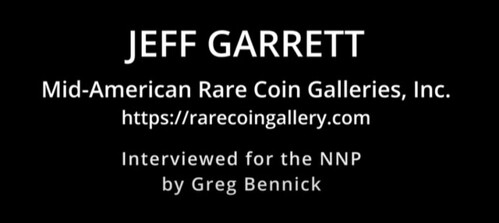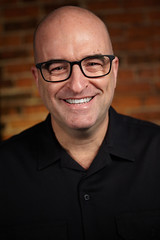
PREV ARTICLE
NEXT ARTICLE
FULL ISSUE
PREV FULL ISSUE
JEFF GARRETT INTERVIEW, PART TWOHere's part two of Greg Bennick's interview with dealer and Redbook Editor Jeff Garrett, where the topic turns to pricing. -Editor
Greg Bennick: It's funny you mentioned the 100 Greatest. I actually bought the fifth edition
last night, and the reason was yesterday, in anticipation of the interview, I was reading the
copy I've had for years and years and I was looking at it, I was like oh, the 1913 Liberty
nickel, I gotta ask him about the 1913 Liberty nickel. And then in the first edition, it says
only the location of only four of these is known. I'm like, it's probably time for me to get an
updated edition, so I bought the fifth last night. I was going to ask about valuations because
there's so many different factors I assume that go into valuation. Meaning if someone came
to me in five minutes with an 1804 dollar and said,
So, it's a coin that's totally like right in the middle, not high end, not low end because you could find extremes on almost every coin that you see where one would be selling. But valuations now are a lot to do, you know, the supply and demand factor comes in really heavily when these people go to battle for these set registry competitions. So, I never thought in my career I would see, like last night also Stuart Blay's collection of Lincoln Pennies is what I'm referring to. A 1919 penny sold for $400,000, which if you'd asked me 20 years ago, would a 1919 penny be worth $400,000? I would've said, well gas must be $500 a gallon by then or something crazy. But it is what it is, you know, people compete because they want to have the finest known and they want to have the finest known set and it's probably more set registry driven that's making that happen. And that set registry competition is one of the things that almost distorts the values because people will pay far more than a coin's worth just because they want to be number one in the set registry. So that's a big factor. But in general, when I'm doing pricing, I have to price for Red Book, everything from colonials to double eagles at the back of the book. And that is one advantage that I have that probably other previous editors, like even Ken Bressett, he's a brilliant guy, but I buy and sell millions of dollars worth of coins a year. And I have an intuitive idea of what a coin's worth just by my handling of coins. So my job is to know what a coin's worth, and that's what most highly skilled professionals have to do. You have to be able to understand, within five or 10%, what a coin is probably worth. Greg Bennick: So before we set off a frenzy, like the era of Max Mehl, looking for the 1913 liberty nickel on having the entire country frantically about looking for this coin, let's point out to viewers that it wasn't just a 1958 penny that sold. And not just a 1919 penny that sold because the coins that sold last night, sure, 1958 Double Die, three known, if I'm not mistaken. Jeff Garrett: Two known, I thought, but could be three. Greg Bennick: Yeah, so could be three. And then the 1919 Penny in MS-69, graded beautiful, perfect. Jeff Garrett: A fantasy grade. Greg Bennick: Yes…fantasy graded. These are exceptional, just unbelievable coins and yet still, it's like you said, it's just hard to place value,. I didn't happen to have the $1.1 million in my pocket. I'm an error guy, right? I'm on the board at CONECA and mint errors are basically my life. And yet still, I never would've anticipated that the 1958 penny would've sold for that. Like you said, supply and demand and it's really hard to pin down. If the coin is gorgeous, then it's simply worth more. But it's really good to know that the guidebook, like you said, is a baseline for the average coin. That's really good to know. Because then people can interpret coins as art and then price them accordingly when they see them. Jeff Garrett: Yeah, it's funny you just mentioned the coins as art. So, for a long long time people are saying really great coins are underpriced compared to great paintings. You know, there's been paintings bringing a hundred million for quite a while. You know, 50 million is like, you know, there'll be a painting selling for $30, $40 million. I've never even heard of the artist now. And I read about that stuff pretty often and coins have finally kind of been coming into that realm where the greatest of the great are bringing really unbelievable prices. And one of the reasons for that, is we have what I call the age of the billionaires coin collectors. And right now I know four or five of them for sure multi-billionaires that have decided coin collecting is their thing. And they've spent $200, $300, $400 million on their coin collections, which is a staggering amount. And when those guys go to battle for a coin, it's like lights out.
I was just doing the Red Book final prices a couple weeks ago and I noticed a 1794 half
dollar sold 2 years ago for what I thought was a staggering price of $850,000 or maybe
880,000, I think what it was. MS-64 plus finest known of course. And when that happened a
couple years ago, I thought, wow, Greg Bennick: Oh, I'm sure it does. Absolutely. Well, let's talk just for a second about grading. I mean, you're known as a grader. How did grading first become important to you and when did you realize you had these skills and what were the skills that made you a great grader early on? Jeff Garrett: And it's funny, grading has been an evolving process because what coins graded 30 years ago, you know, like a glacier, now it's a little bit different. So, it is actually a moving target you have to keep up with to understand it. I've always known that grading was really key to being a successful coin dealer. I actually teach Advanced Coin Grading for the summer seminar at ANA now in the summer. So I teach that and we get a lot of young people who are interested in being professional coin dealers. You know, it's kind of hard to describe. It's kinda like people will show me a coin and I'll tell them a grade and they say well, how do you know? And I say, well if you show a diamond to an expert diamond guy, I couldn't tell the difference, but they can tell you if it's a real diamond or not by probably just glancing at it. And grading is a very nuanced thing and it's something that you just have to do by experience. And I tell people that you gotta start somewhere. I tell people to start with Morgan dollars: if you can learn how to grade Morgan dollars, you can maybe extrapolate that to other series because they're big coins. You can see them and you can see the things that come into it, but grading is very complex. I mean these days it's not about just seeing detail. You gotta be able to understand if it's artificially toned or if it's got things you don't see happen. But I think in general, grading is just something you have to do by experience. And one of the things I teach my class, I tell people what you can do is go to an auction. Even if you're not gonna buy anything, look at auction lots, study them very carefully. The coin's already been graded by the grading services once, so it gives you one point of reference. Then when the auction results are over, go back and try to figure why did one bring like twice the catalog price and one brought half the catalog price. Then you can maybe see that actually by looking at them. So, for me, I learned by experience and I don't know, I guess some people have an eye for it. And I've seen times where I've had employees over the years where I've tried to teach them and it goes into one ear and out the other, and some people just can't grasp it. So I'll call it a skill and some people have it and some people don't. That's probably the best way to describe it, I guess. Greg Bennick: What was it like being one of the early graders at PCGS? I mean, you were there at the very beginning. What was that experience like? Because that was transformative.
Jeff Garrett: Yeah, it was a lot of fun to be there. When they first started, they didn't have
full-time graders. You'd come out and grade for a week. I lived in Kentucky at the time, and I would go to California for a week. We'd live in an apartment. It was kind of like a dorm
lifestyle and I enjoyed it. It was fun to do. And I probably didn't fully appreciate how
transformative it was gonna be when I was doing it. You know, we were like, So it was fun in the beginning and then I eventually had to make a decision, do I want to live in California and do it full-time? So that was the positive I learned about it. But the negative was, I personally don't have the mentality or the mental state to sit in front of a light and grade coins all day long, every day. And I want to be on the phone, like doing a deal or going to a coin show. I don't have the attention span to sit uninterrupted for eight hours a day grading coins. So, it's not for everybody, it's something you have to be able to do and have the right focus in being able to do it. So, I could do it very effectively, but I didn't enjoy it. And then at some point I decided that really wasn't going to be the lifestyle I wanted to pursue. So, I stayed with being a professional coin dealer. But it was fun to be there in the beginning and also seeing all the great characters, David Hall and all the other people who were around there. So eventually it'll end up being like you were kind of like with the legends of numismatics and it was fun to be around when that was going on. Greg Bennick: Yeah, I would think that grading coins would be really fun at first. And I have a friend who's a grader and I think it'd be really fun at first. I think after seeing my 35,000th MS 64 walking liberty half, I think maybe the fun would diminish slightly. Jeff Garrett: Try grading MS 69 and Ms 70 Silver Eagles all day long for two weeks and see how you like that. Yeah, long as they're putting great coins in front of me, it could probably get my attention, but at some point it gets kind of dull. But it is interesting though because you do see a lot especially in these professional companies, they've got people trying to trick them every day, all day with this or that, artificial coins and stuff, so definitely have to be on their toes. So, I admire what they do, it's a tough job. Greg Bennick: Absolutely, I can't imagine the focus and the attention and the skill and the encyclopedic knowledge of coins it would take to do that work, so yeah, it'd be pretty amazing. Now for those who don't remember and I'm old enough to remember myself, but describe what happened when PCGS came around and when slabs and grading came around and how that shifted grading. You touched on it, but I know I talked to my dad, for example, my dad started collecting 1949, 1950, and he describes going into a coin shop, you'd have a conversation with the dealer: I think it's this….I think it's uncirculated….really?...I think it's XF and then you just have a conversation, you come to an agreement that was the grade and you were good. So just describe - because I think it's a hugely important moment in numismatic history - the shift that happened when all of a sudden we began slabbing coins.
Jeff Garrett: Yeah, before that there were a lot of guys that would, like the classic line, a lot
of them would say,
So, 35 years later they've gone down by a lot. So, what it did is it basically commoditized
coins where like I want to buy 200 MS-65 Morgans, and I know exactly what they are
because they have been certified as MS-65. So, people like investors are like
To watch the complete interview on NNP, see:
To read the earlier E-Sylum article, see:
Wayne Homren, Editor The Numismatic Bibliomania Society is a non-profit organization promoting numismatic literature. See our web site at coinbooks.org. To submit items for publication in The E-Sylum, write to the Editor at this address: whomren@gmail.com To subscribe go to: https://my.binhost.com/lists/listinfo/esylum All Rights Reserved. NBS Home Page Contact the NBS webmaster 
|



